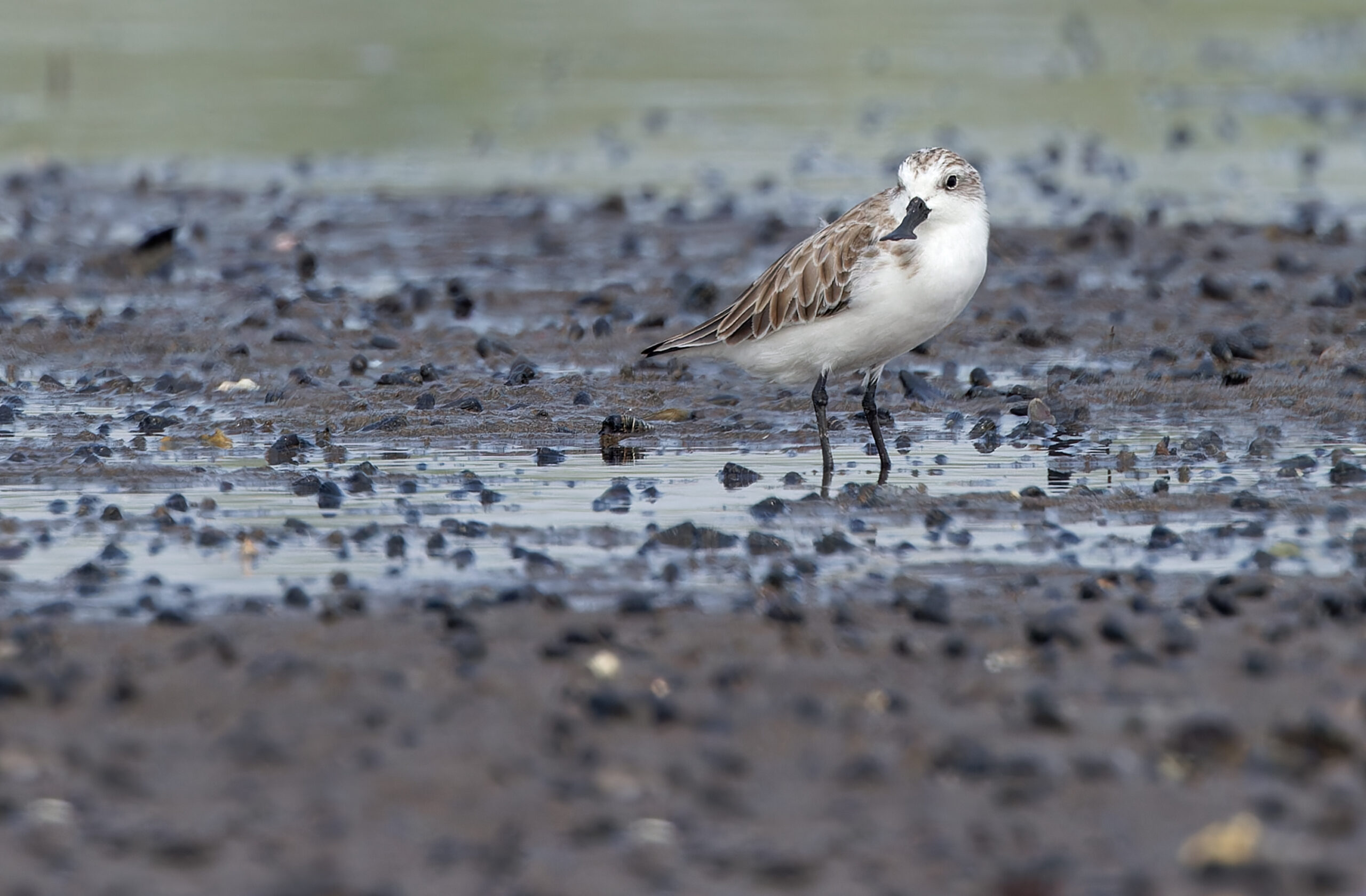World’s rarest, most threatened migratory shore bird seen in PH

A WADER IN DANGER Seeing this spoon-billed sandpiper in Balanga, Bataan, recently has given conservationists stronger arguments for the protection of Manila Bay—before none of it is left as a suitable feeding and migration stop for bird species of such importance and fragile state. | PHOTO BY ROB HUTCHINSON/CONTRIBUTOR
In a historic moment for Philippine avian biodiversity, the world’s rarest and most threatened migratory shorebird has been sighted for the very first time in the country.
The spoon-billed sandpiper, with a global population estimated at around 490 mature individuals, is a critically endangered species on the Red List of the International Union for Conservation of Nature.
The discovery, made by a team of birders at a mudflat in Balanga, Bataan, on March 7, has set wildlife enthusiasts and conservationists abuzz with excitement.
Wildlife biologist Bob Natural was the first to spot the elusive bird. “How fortunate that the first ‘stint’-looking bird I saw while birding was this very rare and critically endangered bird. I observed it foraging among red-necked stints. I told (Birdtour Asia leader and author) Robert Hutchinson, who stood alongside, ‘I think I have a stint with a spoon-bill. I’m serious, Rob.’
Suitable habitat
“We noted its larger size compared to nearby stints and distinctive feeding action but had to wait another two minutes before it raised its head to finally show its distinctive spatulate bill. That was it. Rob confirmed it was a spoon-billed sandpiper. I really hope it will visit every year, and maybe there will be one more individual or several of them in the future,” Natural said.
Hutchinson added: “The spoon-billed sandpiper is undoubtedly one of the most sought-after waders in the world. Whenever I’ve been asked for my dream bird to see in the Philippines, it’s always been the spoon-billed sandpiper, but I never imagined it would happen.”
The habitat in the area, characterized by coastal mudflats, supports foraging activities by small migratory shorebirds, making it suitable for rare species like the spoon-billed sandpiper. Chinese crested terns were also present at the time, marking only the second recorded sighting in Manila Bay more than a century after its first documented sighting in the Philippines.
“In past visits to Balanga, we’ve also documented the endangered Nordmann’s greenshank and the endangered black-faced spoonbills, highlighting the significance of wetland habitats for the conservation of rare and declining species,” said Hutchinson.
Spoon-billed sandpiper
The call to save the spoon-billed sandpiper now carries added weight as the Philippines joins the list of countries where this enigmatic bird has been documented.
Found breeding in northeast Russia, these birds travel 5,000 kilometers each year to winter in southern China, Vietnam, Thailand, Myanmar and Bangladesh. Along their migratory route, they rely on key coastal wetlands in China and Korea, as well as Japan and Russia.
Before the sighting, the spoon-billed sandpiper has only been classified as a potential vagrant to the Philippines.
Teetering on the brink of extinction within the next decade, the spoon-billed sandpiper offers invaluable insights through each recorded sighting. These observations shed light on its breeding, migration and wintering behaviors. The inclusion of the country in the bird’s range underscores its role in global conservation efforts. It also highlights the significance of Manila Bay as a crucial feeding area for migratory waterbirds, including species of international importance.
As a signatory to the Convention on the Conservation of Migratory Species, the Philippines is committed to protecting migratory species across their habitats. The international agreement provides a global platform for the sustainable use and conservation of terrestrial, aquatic, and avian migratory animals and their ecosystems.
“The north Manila Bay also hosts one of only two overwintering sites in the Philippines of the endangered Nordmann’s greenshank, with a world population of fewer than 1,000 individuals left,” said Arne Jensen, an ornithologist and associate expert of Wetlands International.‘Last call’
For the second time in just three months, he noted, it hosted the near-extinct Chinese crested tern with under 100 individuals surviving. No other coastal wetland in the Philippines hosts as many migratory waterbirds as Manila Bay.
“But even so, how do we help these endangered birds? Less than 2 percent of the bay is protected for migrating wildlife, and the tidal flats where most of them feed are nearly unprotected. Less than 1,000 hectares—a mere fragment of what once was—remain. It is the last call for north Manila Bay’s extremely rare and unique biodiversity. The birds need not just words but real action,” Jensen added.
Biodiversity, livelihood
“For Balanga, Bataan, this discovery reinforces what we already know: the region’s wetland habitats are critical for migratory birds, biodiversity and community livelihoods,” said Mike Lu, president of the Wild Bird Club of the Philippines (WBCP).
Through WBCP’s long-standing partnership with Balanga, support for initiatives like the Ibong Dayo Festival and Asian Waterbird Census, as well as the creation of Balanga Wetland Park all aim to raise awareness and conserve vital wetland ecosystems, he said.
“Recognizing their importance, let’s encourage Filipinos to join us in safeguarding these precious environments, ensuring the preservation of our natural heritage and the protection of not only the newly discovered and rare species but also the diverse array of wildlife that call these wetlands home,” Lu added.
Disclaimer: The comments uploaded on this site do not necessarily represent or reflect the views of management and owner of Cebudailynews. We reserve the right to exclude comments that we deem to be inconsistent with our editorial standards.
